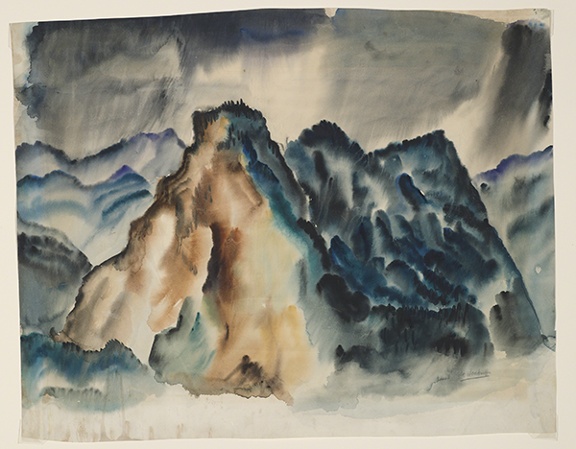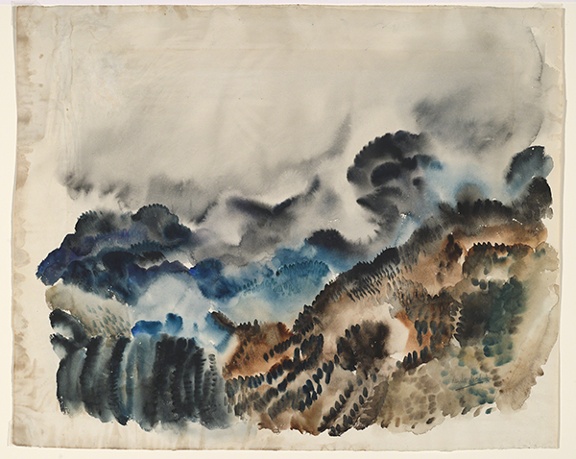Black History Month: Hale Woodruff
Let’s celebrate Black artists who have brought beauty into the world through their art. This week, I’m sharing the stunning watercolors of Hale Woodruff. Since I find watercolor to be a very unforgiving medium for me, I admire an artist who makes it work like Woodruff!
 |
| Hale Woodruff (1900–1980, U.S.), Rocky Mountain Landscape II, ca. 1936. Watercolor on paper, 14" x 18" (35.6 x 45.7 cm). Courtesy of the Brooklyn Museum. © 2024 Artist or Estate of Artist. (BMA-3425) |
In 1933, Woodruff met Grant Wood (1891–1942), who introduced him to the Regionalist aesthetic. Woodruff gradually applied the style to his own work. He also encouraged his students at Atlanta University to find inspiration in parts of Georgia near the university. Rocky Mountain Landscape II is one of several works inspired by the Regionalist choice of recognizable American landscapes for subject matter. This series of watercolors, devoid of social context, recalls influences of Cubism and Expressionism in bold brushstrokes. Woodruff gradually increased his use of abstraction during his later career.
After World War I (1914–1918), many African Americans from the rural South moved to cities in the North. Lasting into the 1960s, this mass movement is called the Great Migration. Although Black men served in World War I, racial prejudice, segregation, and lack of opportunity in the South continued to deny African Americans the hope of fuller participation in society. Black people looked to big cities in the North in the hope of a better life.
Cohesive Black communities formed within cities such as New York, Boston, Cincinnati, and Chicago, where African Americans found a new self-awareness and pride in their heritage. During the 1920s, a significant number of artists lived and worked within these large and varied communities, something that could not have happened in the rural South.
The Harlem neighborhood in New York City was one of the most vital Black communities. The cultural phenomenon that occurred there is called the Harlem Renaissance. In 1928, the Harmon Foundation was founded to promote art and art education for African Americans. This helped spread the enthusiasm of the Harlem Renaissance to other major urban centers with large Black populations. It also funded the foundation of arts programs at major universities.
Born in Illinois in 1900, Woodruff moved to Nashville, Tennessee, with his widowed mother at a young age. He began drawing as a child and started attending the Herron School of Art in Indianapolis in 1919. There, Woodruff trained in the American Impressionist style of fluid brushwork, brilliant color, and quick execution. After winning a Harmon Foundation prize in 1926, Woodruff moved to Paris for four years.
In Paris, Woodruff met Henry Ossawa Tanner (1859–1937), whose style reflected the high-value Impressionist palette. He also learned of Cubism and Expressionism, combining the two styles into quasi-abstract compositions. When he returned to the U.S. in 1931, Woodruff was hired at Atlanta University. He was the first African American professor at a southern university. Throughout his life, Woodruff was a tireless advocate for Black art education. After Atlanta University, he taught at New York University from 1946 to 1970.
Woodruff gradually came to feel that Black artists should create paintings that reflected their surroundings and experiences. However, he openly advised students to embrace more contemporary techniques such as broken color, expressive brushstrokes, and gestural line. His most pivotal works up until World War II (1939–1945) were a series of murals depicting the historic Amistad trials. By the 1950s, Woodruff once again embraced abstraction, referencing the slashing color and decorative surfaces of Abstract Expressionism.
Another beauty from Woodruff’s Rocky Mountain series:
 |
| Hale Woodruff, Rocky Mountain Landscape I, ca. 1936. Watercolor on paper, 14" x 18" (35.6 x 45.7 cm). Courtesy of the Brooklyn Museum. © 2024 Artist or Estate of Artist. (BMA-3424) |
Correlations to Davis Programs: Explorations in Art 2E Grade 1: 4.4; Explorations in Art 2E Grade 3: 5.4; Explorations in Art 2E Grade 4: 4.4, 4.5; Explorations in Art 2E Grade 5: 4.2; Explorations in Art Grade 6: 3.4; Experience Art: 1.3; A Personal Journey 2E: 5.4; A Global Pursuit 2E: 7.1; The Visual Experience 4E: 8.3; Experience Painting: chapter 4


Comments